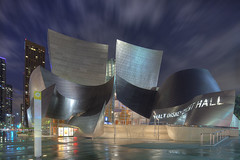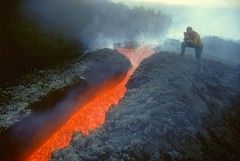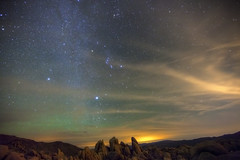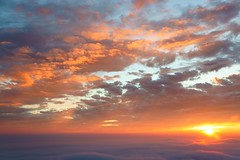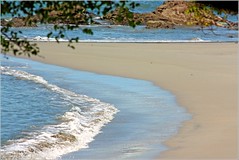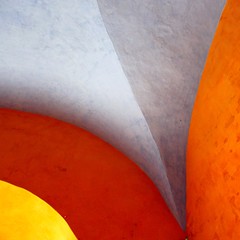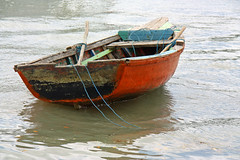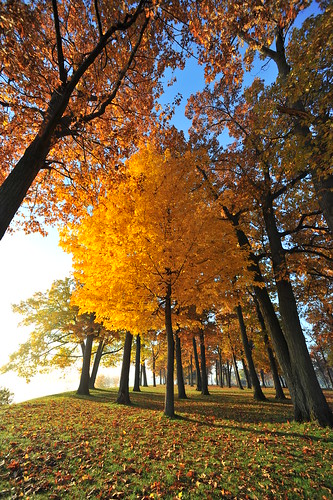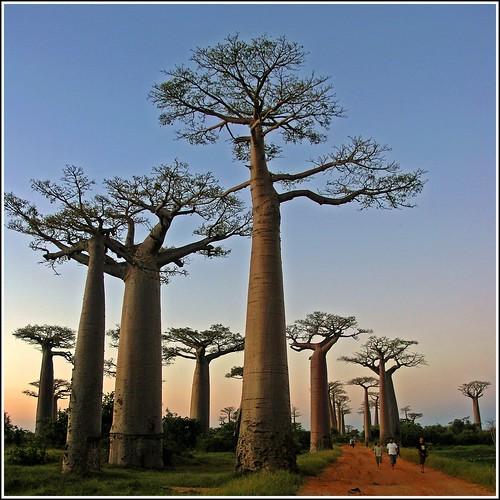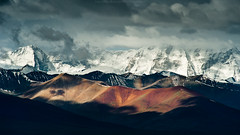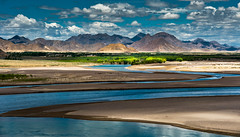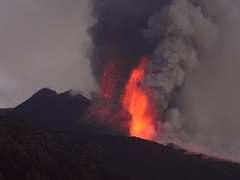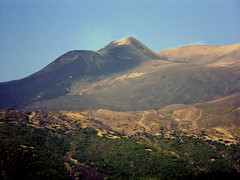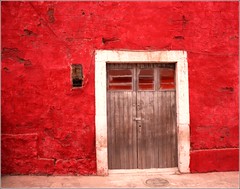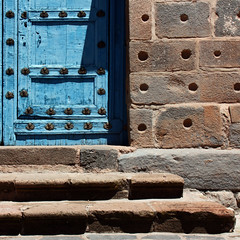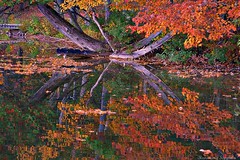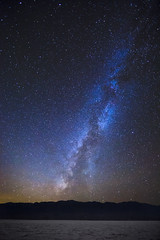at Cartagena de Indias,
Colombia
>:O)
Dec 28, 2011
Dec 26, 2011
Blood of the Earth (Etna, 2004)
On the morning of 7 September 2004, a small crack opened at the eastern base of the Southeast Crater cone and lava began to ooze out, forming a tiny flow just a few hundred meters long before the activity tapered out, a few hours later.
Three days later, on 10 September 2004, the new eruption started in earnest - a new vent opened at about 2600 m elevation, releasing a more substantial lava flow that cascaded down the steep western face of the Valle del Bove. This eruption was peculiar because there was almost no explosive activity, and the emitted lava seemed somewhat "old" - it was coolar and more crystalline than "normal" lava flows at Etna. To make things more serious, the start of this eruption was neither preceded nor accompanied by any noticeable seismic activity, so it came as a total surprise. Luckily it occurred far away from populated areas and cultivated land.
Still, it was a rather large eruption - it lasted six months, until 8 March 2005, and it emitted some 60 million cubic meters of lava, more than the previous eruptions of 2001 and 2002-2003. And it was beautiful, especially so during its first few weeks when weather conditions permitted easy access to the vent and we were frequently there.
This photo was taken during a visit to the active lava flow made with my friend Pippo Scarpinati sometime in late September 2004. At that time, my old Canon AE1 - with which I took this photograph - showed signs of aging, and the my lens had suffered from being too often in dense, acid volcanic gas plumes. Soon I would finally shift from slides and film to digital photography, a step many of my friends and colleagues had done much earlier.
:)
superrrrrrrrrrrrrr............
Mediterranean Masterpiece
Vernazza, Italy
Ahhhhh, k belas férias eu passava aki.... eu e o meu yatch...
Bolazzzzzzzz..... :)
nice shoot!!!
:))
Dec 20, 2011
Dec 17, 2011
BuenOs AirEs
Buenos Aires Time Lapse a video by Pierre Lesage on Flickr.
1000 images shot on 5 seconds interval and assembled in a 30 frames per second time lapse.
*******
SUPERB!!!!
Dec 15, 2011
Un couloir au Louvre
Au début de la Révolution, le Louvre entame une phase d'intenses transformations. Louis XVI s'installe pour trois ans aux Tuileries, puis la Convention lui succède. En 1793, le Museum central ouvre au public dans la Grande Galerie et le Salon Carré. D'année en année, le musée s'étend : les appartements d'été d'Anne d'Autriche accueillent les sculptures antiques, puis naissent les salles du musée Charles X et de nombreux espaces. Les collections envahissent peu à peu l'édifice.
--------------------------------------------------------------------------------------------
With the Revolution, the Louvre entered a phase of intensive transformation. For three years, Louis XVI lived in the Tuileries palace, alongside the Convention Nationale. In 1793 the Museum Central des Arts opened to the public in the Grande Galerie and the Salon Carré, from where the collections gradually spread to take over the building. Anne of Austria’s apartments housed the antique sculpture galleries, and further rooms and exhibition spaces were opened under Charles X.
HDR = 7 shots with 0,5ev assembled in CS5
CaméraSony DSLR-A850
Exposition0,005 sec (1/200)
Ouverturef/8.0
Longueur focale24 mm
Vitesse ISO200
New York City Public Library
The main branch loacated on 42nd and 5th Ave. This beautiful building has so many hallways and stairwells that more resemble a fine mansion or museum then a library.
The hallway in the upper area has an art gallery, while the lower hall leads to some offices and other library specific rooms (books, computers, microfilm, etc).
:)
Dec 14, 2011
Dec 7, 2011
A moment of dramatic change
To us, a group of Etna lovers, photographers, and Alpine rescue service staff, plus myself, the show unfolding before our eyes was beautiful and breathtaking beyond description. Etna once more had invented one of her surprising twists, something we're always certain to see without having the faintest idea what it will be.
The paroxysm lasted some 20 more minutes, then the vents within the crater stopped fountaining; by 06.50 h also the lowest of the newly-formed vent stopped fountaining, and there was some ash emission before all died down - and the cone reappeared from the ash, gas and dust clouds.
It had changed beyond recognition.
Just imagine that dark hump at left was not there nine months ago.
That new vent was a collapse depression, something that is called "pit crater" in the volcanological terminology. This pit crater produced three large paroxysmal eruptive episodes in September and November 2007 and on 10 May 2008, just before the latest flank eruption of Etna. A new, small pit crater opened on 6 November 2009 on the lower east rim of the 2007 pit and gradually enlarged by collapse, and partly coalesced with the earlier pit. This constellation was the place where a first spectacular paroxysm with beautiful lava fountains and flows and a tall ash plume occurred during the moonlit night of 12-13 January 2011, and "the pit crater" became widely known.
Since then, there have been 10 more of these paroxysmal eruptive episodes, on 18 February, 10 April, 12 May, 9, 19, 25, and 30 July, and on 5, 12, and 20 August. Each of these events has thrown considerable quantities of volcanic rock onto the surroundings of the crater, which have gradually piled up into a huge, new volcanic cone, the newest volcanic construct that exists on this planet, and probably the construction is far from finished. This new cone now stands approximately 150 m above the elevation of the original pit crater; if it continues to grow at the same rate through another, say, 10 to 15 paroxysms, it might reach or even overtop the elevation of the old Southeast Crater. Chances are that Etna will continue to produce this sort of activity, since the volcano appears to be structurally stable and a flank eruption appears unlikely in the very short term, so that all magma will have to go to the summit craters. Many people here - including myself - have visions of the new cone standing like a twin next to its older "brother". Time will tell whether you will see, one day, a photo showing the twin Southeast Craters, and then, the younger of the two overtopping its older sibling ??? This is one of the most amazing things a volcanologist can dream of seeing before her or his eyes - the birth of a new volcanic mountain, right from the start.
Photo was taken from near the "Ripe della Naca", on the east-northeast flank of Etna, on the morning of 23 August 2011. Compare this to the images shown in the comments below.

